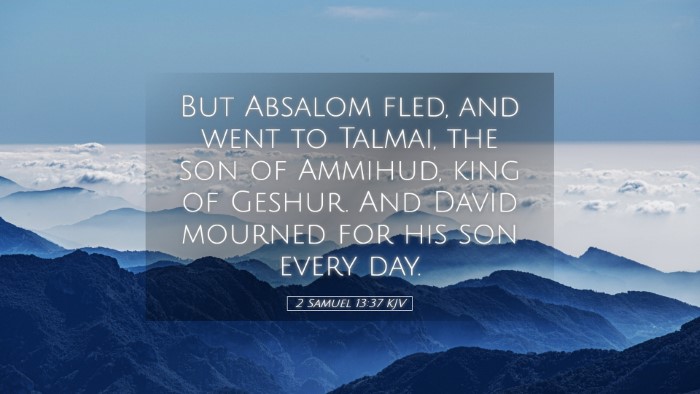Commentary on 2 Samuel 13:37
Verse Text: "But Absalom fled, and went to Talmai, the son of Ammihud, king of Geshur." (2 Samuel 13:37)
Contextual Analysis
This passage occurs within the larger narrative of the tragic events that unfolded in King David's family. Following the assault of Tamar by her half-brother Amnon, her brother Absalom sought revenge for the dishonor brought upon their sister. This fleeing of Absalom to Geshur marks a significant turning point not only in his life but also in the unfolding drama of the royal family.
The Actions of Absalom
- Desperation and Safety: Absalom's flight signifies his desperation following the murder of Amnon (2 Samuel 13:28-29). His immediate concern was for his safety amidst the probable retribution from his father, David.
- Decision to Flee: Scholars argue that Absalom's decision to flee to Talmai, the king of Geshur, illustrates the common practice of seeking refuge among allies in times of conflict (Albert Barnes).
- Symbol of Rebellion: This act of fleeing sets the stage for Absalom's future rebellion against David, indicating a deeper rift in their relationship (Matthew Henry).
The Significance of Geshur
Geshur was a region beyond David's direct control, which made it a natural refuge for Absalom:
- Political Implications: By going to Geshur, Absalom aligns himself with a ruler outside of Israel, hinting at future aspirations and alliances that could threaten David's reign.
- Cultural Context: The journey to a foreign kingdom underlines the societal tensions within the Israelite monarchy and the complexity of familial relationships during this period (Adam Clarke).
Theological Reflections
This passage invites meditation on the themes of sin, consequence, and the seeking of refuge:
- The Weight of Sin: Absalom’s actions, though rooted in justice for Tamar, highlight the destructive cycle of sin and vengeance within families. This reminds modern readers of the pervasive effects of sin (Matthew Henry).
- Divine Sovereignty: Even in Absalom's flight, God's overarching sovereignty is at work within the narrative. It suggests that while humans may make poor choices, God's plans continue to unfold (Albert Barnes).
- The Quest for Peace: Absalom’s search for refuge can be seen as a quest for peace that ultimately he could not obtain through violence and rebellion. This serves as a poignant lesson for individuals seeking peace through means that may not align with God's will (Adam Clarke).
Historical and Cultural Insights
Understanding the historical context further sheds light on Absalom’s actions:
- Asylum Seeking: In ancient Near Eastern societies, it was common for individuals to seek asylum with foreign kings. This reflects cultural practices and the importance of kinship ties (Adam Clarke).
- Role of Kings: The role of a king, such as Talmai, in offering refuge also reflects on the diplomatic relationships between nations at that time, which were often fraught with personal and political nuance (Matthew Henry).
Practical Applications
For pastors and theologians, this passage offers several lessons:
- Family Dysfunction: The Bible is replete with examples of family dynamics that offer ample material for counseling and preaching on the need for reconciliation and forgiveness.
- Seeking True Refuge: Believers are reminded that true refuge is found in God rather than in human alliances or escapes. The importance of turning to God in times of trouble is paramount (Albert Barnes).
- Consequences of Actions: Pastors should emphasize the consequences of sin as evidenced by the lives of biblical figures, making it clear that decisions can have far-reaching impacts on oneself and others.
Conclusion
2 Samuel 13:37 encapsulates a pivotal moment in the narrative of David’s family, illustrating themes of desperation, sin, refuge, and the unfolding of God’s plan in the face of human actions. Through the insights of historical and biblical scholars, we gain a richer understanding of the complexities of this passage. It serves as a reminder of the need for redemption, the seeking of true peace, and the importance of aligning our lives with God’s will.


